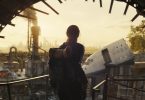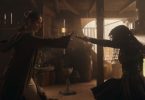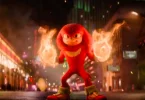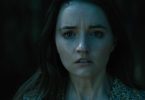Dialect coach Leith McPherson and conceptual designer John Howe were present at Dragon Con this past weekend, and Shakefire had the opportunity to speak with both of them about their work Amazon Studios’ The Lord of the Rings: The Rings of Power. Both are no strangers to Tolkien’s universe. McPherson previously worked on The Hobbit trilogy alongside Peter Jackson, and Howe created conceptual art for both The Lord of the Rings and The Hobbit trilogies as well as illustrations and maps for many of Tolkien’s other works including The Silmarillion. In our exclusive interview, we talk with Leith and John about their involvement in the new streaming series, their process in bring Tolkien’s world to live, and where they find inspiration.
Thank you for taking the time to talk with me. I know you guys are probably gonna be very busy during the convention. Have you been to Dragon Con before?
Leith McPherson: I’ve never been to Dragon Con before. No, it’s something that has been on my list for a long time because, and I felt when we arrived last night that you’re immediately amongst your people, you know? You just feel that. I feel like I can be myself here. I am surrounded by people who are being themselves so it’s fantastic.
Well welcome and congratulations on the launch of Rings of Power. It’s been a long time in the making. Have you had the chance to see some of the fan reactions and stuff. How does it feel having this now out for the world to see?
LM: Well it’s a very strange experience and it started to happen over the last couple of months as clips and trailers and things because we’ve kept it so secret. We’ve kept it secret, we’ve kept it safe. For so long and now it feels it’s a moment of liberation and vulnerability and hope, because we care about it so much and so many people, thousands of people, have put their hearts into this with the humble hope that people might like it and connect to it and find something in it. So it’s that feeling of, “I hope this goes well,” but also joy to be able to share what we care about so much.
John Howe: Yeah, we’re also very aware that this is treading into territory that actually doesn’t entirely belong to any of us who are on this project who may have been on other projects concerning Tolkien, and it’s very much a world that the fans hold so dearly to their hearts. We’re aware of that and we’re hopefully going to arrive there respectfully. On the other hand, we want to try and do something which will have its own presence in its own life.
You’ve both worked on the Lord of the Rings franchise previously so coming back to do this series, how is that for?
LM: Honestly it’s a dream. It’s something when I was doing The Hobbit and working with Orlando Bloom he said to me and I thought it was a casual comment, but I think about it a lot that he said, “You never really leave Middle Earth.” And I think he also means New Zealand as well, but it feels like coming home. So Middle Earth is a place I would spend all my time so I do my very best to do that and to jump at that opportunity. It’s amazing to be back and and it’s thrilling to be in a part of the map, a part of the world, that we haven’t seen before. That, for me as a fan, is deeply intriguing. I look at all of the details of the sets that come up and everything that comes through in the script with this various appetite to explore more of the map. So we get to do that here.
JH: Because if you take all 13 volumes of the history of Middle Earth, The Lord the Rings and The Hobbit and anything to do with those movies only is a tiny, tiny portion, and The Rings of Power is another small bit of that. So this is a vast universe. And I’ve been working in in visuals, in visualizing this world for different projects for many, many years and I’ve feel I’ve only just scratched the surface. And a number of times I’ve been standing almost in a picture somewhere, looking out over the landscape where I know the script will not go wishing, “Oh my god, I wish we had the opportunity to go off and draw Angmar or the Blue Mountains or you know.” Here we’re in a different place; the world is not the same. There’s a sense of familiarity, which is agreeable because there’s continuity and there’s meaning to it. But nonetheless, we’re somewhere else, and that needs to come through.
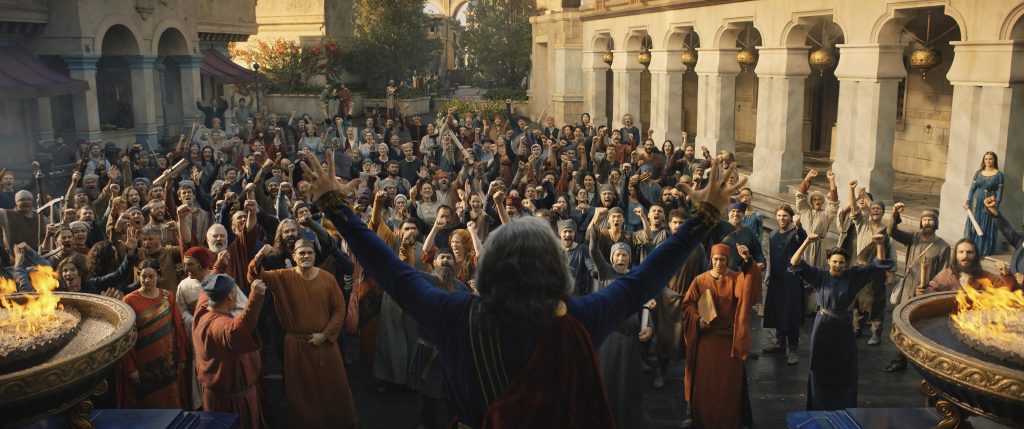
What is that process like for you? Watching those first two episodes, you see Khazad-dûm in its glory. While everybody familiar with The Lord of Rings sees the Mines of Moria as this dark and dangerous place. You don’t get that beauty. But now here we get to see how things were. Being able to visit the past and create these worlds, what was your process like for that?
JH: I’ve often wondered how best to approach a universe in which an episode has been done and then an episode previous to it in time needs to be created, and I don’t believe in retro design, taking what was done and then trying to work backwards. I think you have to go back as close to the spirit of the source as possible and then work forward. And if your intuition is to be trusted, then you will end up in the right place. But Khazad-dûm is a good illustration of the steps behind this project in that we’re not in a waning world where kingdoms have been abandoned and where treasures have been lost, where magic is slowly diminishing and leaving the world, we’re in the middle of it. And it is alive and it is vibrating with that energy. That was one of the aspects of trying to visualize Khazad-dûm. And I think even more so in Númenor.
This is such an ensemble cast and there’s so much in getting the work all that and with the various races, you have dwarves, elves, men, the harfoots; and they all have their individual identities and worlds. And so working on the dialect and the language and how they come across, what was it like working in that process?
LM: It’s extraordinary because all of us, whether it’s JD [Payne] and Patrick [McKay] and their and the writing team, whether it’s the extraordinary artists, like John who are visualizing this world, whether it’s people like, Bear McCreary, the sound team that I get to participate in, we are terraforming. We are literally creating a world with the contribution that we make. And so to actually build an acoustic landscape for each of these cultures it’s such an engaging process for the actors because they feel like they’re part of that creative process. It’s not just a technical thing that they’re having to learn when they work with these languages. It feels like the way by which you literally bring breath and life to your character and all of them to a person engaged with that with a level of passion that I think Tolkien would be really pleased with that. It feels like we have again that desire to have a common vision and goal together to bring as much texture as we can to the world. So that is done with a generosity and collaboration and curiosity that make every day interesting.
Do you have a favorite dialect? Do you have a favorite character that you’ve worked with and help create and shape?
LM: No, we’ve been talking about favorites as well, you know, and that is another joy about the job. I spend a day in Khazad-dûm, or a week in Khazad-dûm and then you head to Lindon or then you head to Númenor, and you completely reset. It does feel like you’re in a different place. I have so much love in me, there’s plenty of places to put it. I’m always curious. I mean, to answer your question, I always get particularly excited when a new language arrives. So vocabulary I haven’t seen before to describe things we haven’t seen before. Those are the moments that I get little prickles on the back of my neck where I think wooo. it’s that joy whenever I get the email and I see what do we get to discover next? And for me that happens through language which is very thrilling.
Well Tolkien created all these elven languages basically out of thin air for you for you both to work with and create and shape around. I’m sure that has been such an immense source and library of knowledge.
LM: Yeah it is, and it’s something you keep coming back to. You go back to the books. You just keep going back to the books and that is the primary source and the rich fountain that we get to draw upon.
JH: Because Tolkien’s sources are myriad and very, very deep. And he was a gracious reader and incredibly knowledgeable philologist. He had all of the academic qualities and he was also someone who writes in pictures. And that’s a quality which is not given to every fantasy writer. When you read any of his texts, no wonder they’re so evocative in terms of imagery because he is literally writing in pictures, he’s writing the emotions of the characters be in face, was what they see, which is the best possible clue you can have as a visual artist because he’s not describing anything in particular, physical detail. He’s giving you the impression of the character. And that’s even more liberating because then you can simply reach back into your experience, your knowledge of his sources, your acquaintance with his world, and you know the images are somewhere there and that’s when you reach out and try and find them.
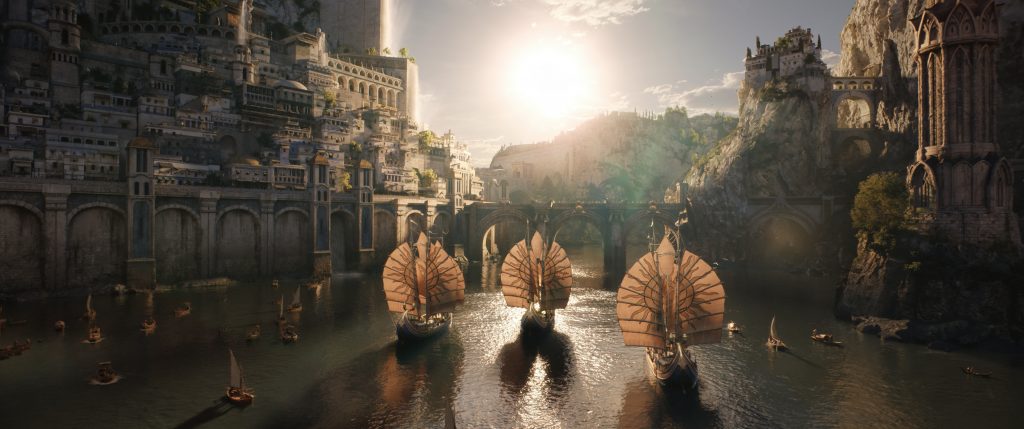
You’ve illustrated many of his works. How has your process changed? Have you looked back on some of your earlier works and seen them in a different light and gone back to the source material. How have things changed for you?
JH: I think the thing in which I am the least interested in this entire world is my own work. It’s done. And it’s part of what I’ve been able to participate in and create, but what I’m really interested in is is where it can go. And I do not, particularly believe things should be set in any way in stone. I quickly get bored if I need to redraw something to be consistent with what I’ve done. So every opportunity is is exciting because you remain unfettered fortunately by the work you’ve done. That’s not important. What’s important is can you reestablish a form of contact with this text? Can you understand perhaps what the author was seeing he or she was writing? That’s kind of a permanent engagement and quest for points of contact between the work and your own experience and the imagery you can create and for the longest time I believed that we had images in our heads and all we had to do was get them out. And those of us who had the capacity to do it where artists, and those who didn’t simply dreamed them.
But I realize now very, very strongly that the images aren’t inside. What we do have in us is the experience, the technical ability, and the desire to find images but those images they’re out in the world. So you need to reach out and find them. It’s this form of imbalance which I think is part of every artistic person. It means you lean into the world all the time. You lean into what you read, you lean into other people’s experiences, you lean into everything that’s around us and that is a permanent engagement with what we share as common culture and that really keeps everything fresh and alive and fluid and moving and of the moment. I think that’s really important because that’s where your intuition can do its job and not fall back on reason thinking and simply do what you feel is right. And hopefully you establish those points of contact, and if you miss then well, it doesn’t matter. You try again.
So what would you say are some of your inspirations outside of Tolkien’s work?
JH: Well all of Tolkien’s inspirations. I know his reading less than I know his library and what he liked to read about and what he was interested in. Also a sense of the haphazard quality of inspiration. I live in Switzerland and when talking was 19 years old, he did a 10 day hiking trip from Interlaken across the Alps and those are the Misty Mountains. It’s clear when you go to the places he went. You can go to this little valley called Lauterbrunnen near Grindelwald and you can go up and stand on one side of the valley and you can see where Rivendell is, literal. And that’s very exciting because that takes you to a world which no longer exists. The early 1900s of Switzerland, there was no power lines, no hydro, no ski resorts; it was a wild alpine landscape and you could imagine this young Englishman, his first big trip abroad, his first little grand tour, crossing that landscape. And yes of course it’s in his work. Then his other sources are myriad, vary and exciting to try and discover. It sends you into worlds of art, art history and culture of every kind. That’s really exciting. That’s part of the quest. If you want to find the best images you can you need to really be attentive 24 hours a day, every day of the year and just look at everything and try and understand. That builds a vocabulary, which is at your fingertips when you need it.
How about yourself? When you find inspiration?
LM: Do you mean apart from that guy? Hahaha. Ugh, you took me to Switzerland and I’m still there. It’s so interesting because I sort of wandered through this world getting to speak with people who have a knowledge of the sort of works that Tolkien would have studied that I don’t have. So Middle English, Old English. Taking me to things like Beowulf, where you are immediately transported into something which feels like such an evocative, rich, dense and sort of measureless world that is captured briefly in a moment, in a phrase of song or whatever it might be. And so you can see Tolkien doing the same thing, which again gives you this sense that you’re just looking at the top of the mountain, the tip of the iceberg of what he was trying to capture. It could be an endless journey in any direction. That’s the thing. You can sometimes get overwhelmed by the fact that the map is so huge, which direction do you go in? But looking at the languages he was interested, in listening to the sounds that he was drawing upon, and again going to the sources, his sources, not just using him as a source but predating Tolkien, just gives you further texture because you have a greater understanding of the writer, which gives you a greater understanding of the work.
JH: And Tolkien loved maps. I’m sure you’ve seen that maps play quite a part in Rings of Power. That whole notion that when we worked on the map of Númenor, it’s coming up on three years ago now. It really is sobering. There was a huge amount of research done actually trying translate a few clues which Tolkien left throughout his work into a map. And none of us know how far it is from Númenor to Middle Earth. Tolkien just does not say. We know how big Númenor was. We know it was out in the ocean, and that the whole coastline of Middle Earth was changed by the sinking of Númenor. All these changes, which to me seemed huge because it was actually going against whatever had been drafted before. And then you look at map itself and you realize there are actually tiny changes. But there’s so many things we did not know. Was such and such a road? Did it existed at that time? Who built it? When it encounters a river, is it a ford or a bridge? Well, we have to try and find out. We don’t know. So that that’s all very exciting and delving back into Tolkien to make a map was really fun. I say fun because that’s honestly what it was being as we try to transpose. It’s like Sherlock Holmes trying to transport clues onto a map. I put in many, many things on that map, which nobody seems to have noticed. So I’m very pleased. I’m waiting for somebody to bring them up one day. But they there are many, many things in that map which have nothing to do with the project initially but they don’t contradict anything because they are physical features which were there. I just thought, “I’ll put them in.”
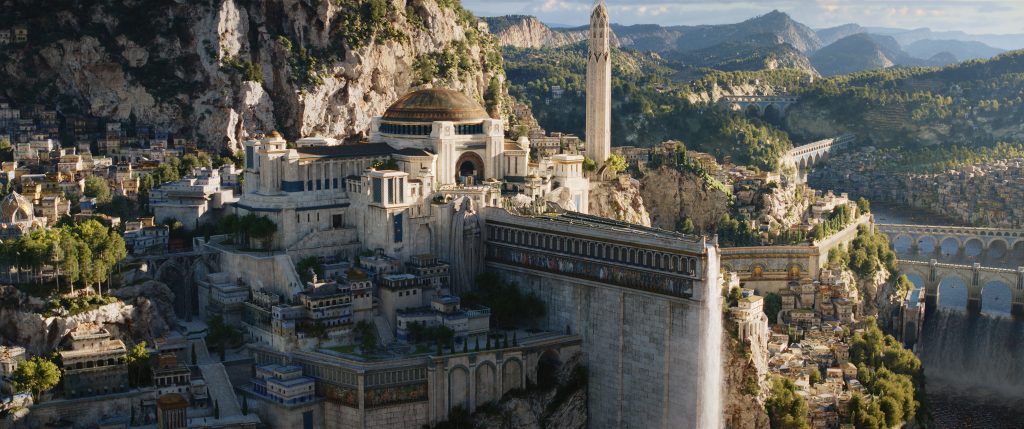
Is there a difference in your approach when working on the films versus now for television series?
LM: I always get surprised when people talk about this as a television series. We’re using the word we have, but it’s so cinematic in its scope if you’ve seen the first two episodes. It has a landscape feel to it that is so literally epic and a process that felt very similar. I mean, working on The Hobbit was four years of my life so that wasn’t a quick turnaround either and this has that same feeling of scale. I don’t know how else you even try to attempt to capture anything of Middle Earth without clearing the decks and rolling out a very large map at the beginning. So it feels like an identical process in a lot of ways.
JH: It’s very much the same thing for me. It’s the same process. Fortunately for my job, it’s very, very far upstream from actual shooting so there’s none of the pressure of the deadlines that you’re under when it gets close to crunch time, but there is an expectation to deliver not only what the showrunners have envisioned but also to add in whatever you can to try and help, to try and broaden the scope, to try and bring in new ideas, to try and shake things up and not do what you’ve done a hundred times before. And just keep everything going, keep that vision fresh and find new ideas. It’s really fun because it’s a blank canvas in areas. So, what you do with blank canvases? Well, a blank canvas is not just a flat white surface. It is an infinite 3d space into which you reach to try and put things and that’s where they are. You have to reach right into that. And then you find that landscape and you can broaden it out to make it your own.
The Lord of the Rings: The Rings of Power is now streaming on Amazon Prime Video, with new episodes dropping weekly every Friday.


